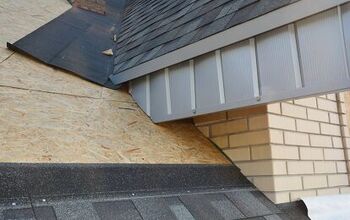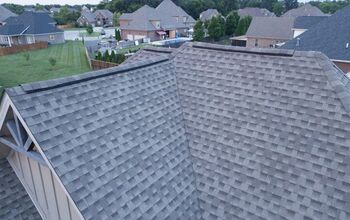What Is Gutter Flashing? (Find Out Now!)

Keeping a roof over your head is only half the battle. That roof must also be waterproof and sturdy enough to handle all weather conditions. So, homeowners usually install flashing to help improve their home’s appearance and keep it protected.
Gutter flashing is crucial because it helps prevent water damage to your house. Flashing is typically long and made from aluminum or plastic. You install it between your roofline and gutter to stop moisture from running down your exterior walls.
Do You Need Roofing, Siding, or Gutter Installers?
Get free, zero-commitment quotes from pro contractors near you.

What Is the Purpose of Flashing on a House?
Flashing is usually thin and pliable, but that doesn’t mean it’s not strong and durable too. Builders will put strips of flashing at crucial intersections to direct water flow away from the house. So, you’ll find most gutter flashing around windows, doors, and foundations.
What Are the Different Types of Roof Flashing?
Just like there are many different types of gutters, there are also many different types of flashing. For example:
- Apron Flashing: This is also known as continuous flashing because it uses a single piece of metal to direct water down the side of your house.
- Step Flashing: With this type, you use a rectangular piece of flashing and bend it 90 degrees to sit flush with corners and angles.
- Base Flashing: This kind is best where two flashing pieces come together for extra support.
- Counter Flashing: You place pieces opposite the base flashing to create a watertight pattern with counter flashing.
- Valley Flashing: This kind helps protect the nooks, crannies, and divots on your multi-faceted rooftop.
- Kickout Flashing: Contractors use this type to connect spots where the step flashing ends, and the gutter begins.
You might encounter drip edges as well. That’s because drip edges help builders prevent water damage to the home due to unforeseen leaks and damage. But be sure to ask a roofer for more information about the materials and techniques needed for your house.
Should a Roofer Replace Flashing?
Usually, roofers will repair or replace flashing when they finish installing a new roof. So, you should never install new flashing over old flashing because it can trap moisture and cause water damage. Instead, pay for replacements when getting your gutters repaired.
DID YOU KNOW: Installing new gutter flashing is the best way to guarantee quality outcomes when fixing your roof or gutters.
How Do You Install Roof Flashing Gutters?
Installing gutters can be a challenge, so installing roof flashing may also require an expert hand. However, it might also depend on the materials you use and the configuration of your roof. For example, it’s generally easier to repair or replace simple roof flashing angles. But intricate ones are harder. Plus, you don’t need as many tools to cut vinyl as you do copper, tin, or aluminum.
Does Flashing Go Over or Under Shingles?
In most cases, the flashing on your house needs to overlap the material covering your roof. So, that means it needs to go over your shingles. This is how you stop water from getting in between the layers.
For aesthetic purposes, some asphalt roofs lay flashing under the shingles. That way, people can’t see the seams. Then, roofers often cover the flashing with a course of shingle tabs to help hide it even more.
Is Roof Flashing Necessary?
Roof flashing is necessary, especially if you live in an area with lots of heavy rainfall. Meanwhile, flashing is corrosion-resistant and made from metals like copper, aluminum, or steel. It’s also thin, flat, and flexible to help roofers install it on different structures.
Without roof flashing, the shingles and underlayment on your home become vulnerable to moisture. Then, excessive humidity can warp the studs in your walls or damage your floors. So, yes, flashing is essential no matter where you live. But keep your gutters clean to ensure they always work correctly.
Related Questions
Should You Paint Roof Flashing?
If you can paint your gutters, you can paint your gutter flashing as well. Remember, though, flashing pieces and gutters come in a variety of colors already. So, it might be easier to buy pre-painted products to save time.Either way, try to paint your flashing to match the color of your trim. And always let professional painters know your intentions. That’s because new flashing materials may require a bonding primer to hold exterior paint.
How Much Does Flashing on a Roof Cost?
The cost of flashing on a roof can vary depending on several factors. For example, the size and material may affect the price, but so can the linear footage. However, the average cost of installing flashing on a roof is between $45 and $75 per linear foot.
Do Gutters Need Flashing?
Flashing plays a significant role in a beautiful, comfortable, and durable home. That’s because it helps create a seal between your gutters and your roofline. So, water won’t freely flow behind your gutters and run down the walls or cause as much damage.
How Long Does Flashing on a Roof Last?
If you install flashing correctly, it should last for quite a while. Professionally installed flashing usually lasts between 20 and 30 years. However, the lifespan of gutter flashing depends on several factors.Details like the size and shape of your roof, where you live, and which materials you choose can affect how long flashing lasts. So, pay attention to the installation dates and maintain your gutters with regular flushes.
Do You Need Roofing, Siding, or Gutter Installers?
Get free, zero-commitment quotes from pro contractors near you.

A Home That’s Functionally Beautiful
Gutter flashing may seem like a mundane detail, but its job is vital. With it, your beautiful home could get damaged by rainwater and other weather conditions. Plus, flashing can help improve curb appeal because it softens the look of gutters and facia.
So, live in a functionally beautiful home and be protected for years to come. Install gutter flashing or hire professionals to do it for you.
Related Guides

Tiffany Nichols specializes in aesthetics, design, marketing, and manufacturing. She's a copywriter and editor for several home renovation companies in the U.S. and works alongside some of the biggest names in the industry. Her hobbies include architecture, art, mental health, and fashion.
More by Tiffany Nichols



























